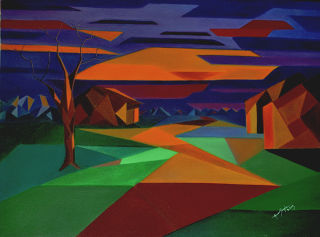Cubism Paintings
-
CountryCountry
-
StyleStyle
-
MediumMedium
-
SubjectSubject
-
SizeSize
-
AgeAge
-
PricePrice
-
UsersAccount
-
Color
Cubism is an art style which symbolized the end of Renaissance-dominated era with its traditional mediums, views and ways to paint and the beginning of completely new Modern art period. With Pablo Picasso and Georges Braque as a founders, it was developing for 7 years (from 1907 to 1914) and it is traditionally classified into three main periods:
- Early Cubist Paintings (1907-1909);
- Analytical Cubism (1909-1912);
- Synthetic Cubism (112-1914).
Appearance of Cubism
Unlike other styles of art, it is easy to tell when Cubism era started. That happened in 1907, when Picasso, inspired by African tribal art exhibition and seeking for a new methods, finished his Les Demoiselles D'Avignon — a significant masterpiece, one of most popular works of an artist.
The term “Cubism” was formed by the end of 1911. This form of visual art is not easy to understand — it's intellectually challenging and very symbolic. The viewer need to put an effort to get the ideas depicted on a painting.
Analytical and Synthetic Cubism
While Early Cubist Paintings were displaying objects making parts of them look like geometric shapes, the following two used absolutely new techniques — there were no more cubes on the canvas.
Analytical Cubism is completely different to Synthetic one, which appeared a little later. The painting technique of the first one requires breaking the image into pieces and then re-assembling them. Second one synthesize an image from various elements and shades that have never been a single image.
Picasso was indeed a key figure in development of this style — he became the founder of Analytical Cubism when created Portrait of Ambroise Vollard, where the human figure was disassembled onto small parts, and each of them overlapped other and they all intersected at different angles. Now the main elements are plates and lines.
Synthetic Cubism artists used two main techniques: collage and papier colles (pasted paper from French). Braque was experimenting with techniques and medium — used stencilled lettering, added sand to paints. After this started a trend to use everyday materials like newspaper, cloth, tickets etc. to create artworks. Synthetic Cubism made a huge influence on the following art styles — Dada, Surrealism and Pop-Art.
About ART.Biz
ART.Biz is an online gallery that offers only original artworks — no copies or prints. On our website can be found works of modern artists of all Cubism styles and other art schools. We want to create a perfect place where artists, buyers, collectors and dealers could cooperative effectively so join us and enjoy the art.











